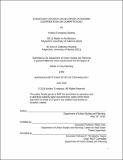| dc.contributor.advisor | Albert Saiz. | en_US |
| dc.contributor.author | Torregrosa Santana, Andrea | en_US |
| dc.contributor.other | Massachusetts Institute of Technology. Department of Urban Studies and Planning. | en_US |
| dc.coverage.spatial | e-sp--- | en_US |
| dc.date.accessioned | 2016-10-25T19:16:53Z | |
| dc.date.available | 2016-10-25T19:16:53Z | |
| dc.date.copyright | 2016 | en_US |
| dc.date.issued | 2016 | en_US |
| dc.identifier.uri | http://hdl.handle.net/1721.1/104980 | |
| dc.description | Thesis: M.C.P., Massachusetts Institute of Technology, Department of Urban Studies and Planning, 2016. | en_US |
| dc.description | This electronic version was submitted by the student author. The certified thesis is available in the Institute Archives and Special Collections. | en_US |
| dc.description | Cataloged from student-submitted PDF version of thesis. | en_US |
| dc.description | Includes bibliographical references (pages 75-77). | en_US |
| dc.description.abstract | Subsidized housing construction is one of the main policy instruments used in Spain to facilitate the access to affordable housing. Public companies, private developers and cooperative associations coexist as providers of these subsidized units. Due to the financial crisis, some of the public companies have decided to stop their role as developers and to focus on the management of their rental stock. This study describes the Spanish subsidized housing system and analyzes the interaction among the three types of developers to understand whether public companies should continue with their construction activity or become a different kind of player. Focusing on the Region of Madrid, we worked with data on the subsidized housing projects built from 2005 to 2014 and tested for the existence of a crowd-out effect at the district level. We analyzed the effect for the 10-year period, and afterwards we analyzed it separately for the housing market boom (2005-08) and bust (2009-14) periods. Our results suggest that a crowd-out effect exists between public and private developers in the three periods of analysis. However, cooperatives show a tactical alternation with public companies when analyzed at the boom and bust periods, but a strategic complementarity when analyzed as a single 10-year period. In the short term, a crowd-out effect exists between cooperatives and public companies, but in the long term there is a crowd-in effect. Although an analysis of the type and quality of the housing provided by each developer would be needed to complement this study, results suggest that the decision of public companies to change their role from active developers to service providers could benefit the whole subsidized housing sector. If the right incentives persist, private companies and cooperatives will continue to construct new subsidized housing units, whereas public companies can follow a complementary housing policy, focused on promoting rental units and refurbishment of existing buildings in city centers. | en_US |
| dc.description.statementofresponsibility | by Andrea Torregrosa Santana. | en_US |
| dc.format.extent | 77 pages | en_US |
| dc.language.iso | eng | en_US |
| dc.publisher | Massachusetts Institute of Technology | en_US |
| dc.rights | M.I.T. theses are protected by copyright. They may be viewed from this source for any purpose, but reproduction or distribution in any format is prohibited without written permission. See provided URL for inquiries about permission. | en_US |
| dc.rights.uri | http://dspace.mit.edu/handle/1721.1/7582 | en_US |
| dc.subject | Urban Studies and Planning. | en_US |
| dc.title | Subsidized housing developers in Madrid : cooperation or competition? | en_US |
| dc.type | Thesis | en_US |
| dc.description.degree | M.C.P. | en_US |
| dc.contributor.department | Massachusetts Institute of Technology. Department of Urban Studies and Planning | |
| dc.identifier.oclc | 959889542 | en_US |
